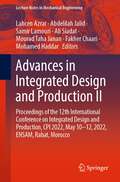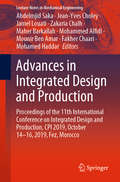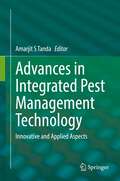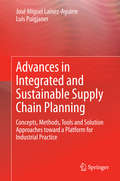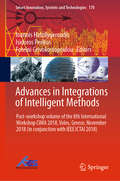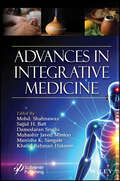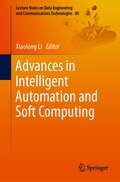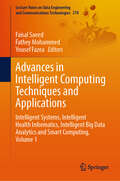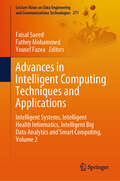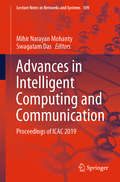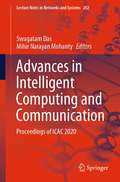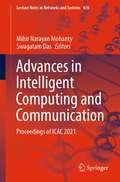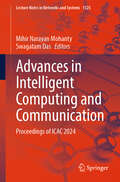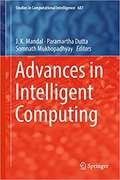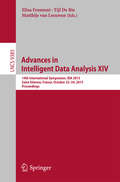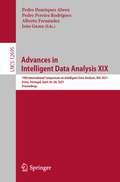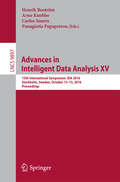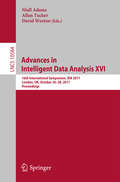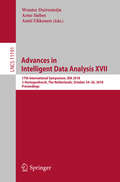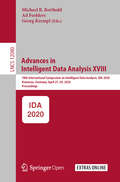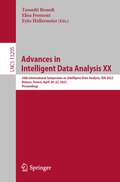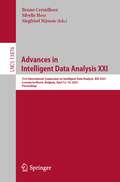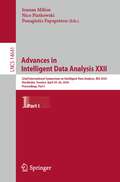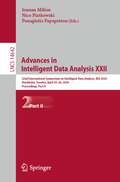- Table View
- List View
Advances in Integrated Design and Production II: Proceedings of the 12th International Conference on Integrated Design and Production, CPI 2022, May 10–12, 2022, ENSAM, Rabat, Morocco (Lecture Notes in Mechanical Engineering)
by Fakher Chaari Mohamed Haddar Samir Lamouri Ali Siadat Lahcen Azrar Abdelilah Jalid Mourad Taha JananThis book reports on innovative concepts and practical solutions at the intersection between engineering design, production and industrial management. It covers cutting-edge design, modeling and control of dynamic and multiphysics systems, knowledge management systems in industry 4.0, cyber-physical production systems, additive and sustainable manufacturing and many other related topics. It also highlights important collaborative works between different countries and between industry and universities. Gathering the proceedings of the 12th International Conference on Integrated Design and Production, CPI 2022, held on May 10-12, 2022, at École Nationale Supérieure d'Arts et Métiers (ENSAM), in Rabat, Morocco, this book gathers carefully peer-reviewed chapters, with extensive information for researchers and professionals in the broad area of engineering design, production and management.
Advances in Integrated Design and Production: Proceedings of the 11th International Conference on Integrated Design and Production, CPI 2019, October 14-16, 2019, Fez, Morocco (Lecture Notes in Mechanical Engineering)
by Jean-Yves Choley Fakher Chaari Mohamed Haddar Mounir Ben Amar Maher Barkallah Jamel Louati Abdelmjid Saka Zakaria Chalh Mohammed AlfidiThis book reports on innovative concepts and practical solutions at the intersection between engineering design, engineering production and industrial management. It covers cutting-edge design, modeling and control of dynamic and multiphysics systems, knowledge management systems in industry 4.0, cyber-physical production systems, additive and sustainable manufacturing and many other related topics. The original, carefully selected, peer-reviewed chapters highlight collaborative works between different countries and between industry and universities, thus offering a timely snapshot for the research and industrial communities alike, as well as a bridge to facilitate communication and collaboration.
Advances in Integrated Pest Management Technology: Innovative and Applied Aspects
by Amarjit S TandaThe UN's Food and Agriculture Organization defines integrated pest management (IPM) as "the careful consideration of all available pest control techniques and subsequent integration of appropriate measures that discourage the development of pest populations and keep pesticides and other interventions to levels that are economically justified and reduce or minimize risks to human health and the environment. IPM emphasizes the growth of a healthy crop with the least possible disruption to agro-ecosystems and encourages natural pest control mechanisms. "Although this is a concept championed since the 70s, recent advances in agricultural biotechnologies and unfortunately, new problems brought on by global climate change warrant a reevaluation of how IPM can be implemented. This book aims at bringing out a comprehensive collection of information on all aspects of advances in integrated pest management technology in agriculture systems worldwide. The main focus of this book is to address the nano-biotechnology as sustainable solutions, biogenetic insect resistant plants in integrated pest management technology (IPMT), and DNA barcoding of insects and role of protease inhibitors in recent management trends. It also highlights the advances in integrated management of insect pests of stored grains, and use of bee pollinator’s as a livelihood security to the people worldwide. Step-by-step descriptions, accompanied by numerous photographs and schematic drawings, are provided on IPMT under changing climate, and habitat manipulation in crops. This book thus provides a forward-looking foundation for IPMT systems and its use in crop production.
Advances in Integrated and Sustainable Supply Chain Planning: Concepts, Methods, Tools and Solution Approaches toward a Platform for Industrial Practice
by Luis Puigjaner José Miguel Laínez-AguirreDecision making at the enterprise level often encompass not only production operations and product R&D, but other strategic functions such as financial planning and marketing. With the aim of maximizing growth and a firm's value, companies often focus on co-ordinating these functional components as well as traditional hierarchical decision levels. Understanding this interplay can enhance enterprise capabilities of adaptation and response to uncertainties arising from internal processes as well as the external environment. This book presents concepts, methods, tools and solutions based on mathematical programming, which provides the quantitative support needed for integrated decision-making and ultimately for improving the allocation of overall corporate resources (e. g. , materials, cash and personnel). Through a systems perspective, the integrated planning of the supply chain also promotes activities of reuse, reduction and recycling for achieving more sustainable environmental impacts of production/distribution networks. Thus, this book presents, for the first time, a unique integrated vision of the Enterprise Supply Chain Planning and provides a comprehensive account of the state of the art models, methods and tools available to address the above mentioned features of the modern supply chain. It offers a comprehensive review of the associated literature of supply chain management and then systematically builds on this knowledge base to develop the mathematical models representing each of the core functional units and decision levels of the corporation and shows how they can be integrated into a holistic decision problem formulation. Abundant illustrations and tables help maximize reader insights into the problems discussed with several case studies and industry application also examined. This book is intended as a textbook for academics (PhD, MSc), researchers and industry decision-makers, who are involved in the design, retrofit and evaluation of alternative scenarios for the improvement of the supply chain.
Advances in Integrations of Intelligent Methods: Post-workshop volume of the 8th International Workshop CIMA 2018, Volos, Greece, November 2018 (in conjunction with IEEE ICTAI 2018) (Smart Innovation, Systems and Technologies #170)
by Ioannis Hatzilygeroudis Isidoros Perikos Foteini GrivokostopoulouThis book presents a number of research efforts in combining AI methods or techniques to solve complex problems in various areas. The combination of different intelligent methods is an active research area in artificial intelligence (AI), since it is believed that complex problems can be more easily solved with integrated or hybrid methods, such as combinations of different soft computing methods (fuzzy logic, neural networks, and evolutionary algorithms) among themselves or with hard AI technologies like logic and rules; machine learning with soft computing and classical AI methods; and agent-based approaches with logic and non-symbolic approaches. Some of the combinations are already extensively used, including neuro-symbolic methods, neuro-fuzzy methods, and methods combining rule-based and case-based reasoning. However, other combinations are still being investigated, such as those related to the semantic web, deep learning and swarm intelligence algorithms. Most are connected with specific applications, while the rest are based on principles.
Advances in Integrative Dermatology
by Katlein França Torello LottiAn authoritative overview of contemporary approaches to integrative skin health The popularity of integrative medical treatment of skin disorders has increased significantly in recent years—requiring practicing clinicians to keep pace with continuingdevelopments in dermatological research and methods. Advances in Integrative Dermatology offers a comprehensive survey of this dynamic field, providing up-to-date information on both preventative and therapeutic approaches to skin health. Combining clinical medicine with complimentary treatment plans, integrative dermatology provides an innovative perspective to individual patient care. This essential text explores new research in areas including the effects of stress and pollution on the skin, the importance of high-quality sleep, complementary methods of averting skin conditions, and more. Recognizing the impact skin disorders have on physiological, psychological, and emotional health, editors Katlein França and Torello Lotti illustrate key components of inclusive skin health strategies, such as therapeutic diets and nutritional supplements, topical botanicals, and other complementary therapies. Filling a significant gap in current literature on integrative dermatology, this valuable resource: Answers the common questions asked by patients in real-world dermatology practices Addresses pervasive misconceptions of integrative dermatological methods and principles with evidence-based review of current practices Examines contemporary research in the diagnosis and treatment of dermatological disorders Presents comprehensive treatment options for a wide range of conditions such as rosacea, melanoma, and psoriasis Advances in Integrative Dermatology is an indispensable volume for physicians seeking to incorporate holistic techniques into their practices, expand their knowledge of integrative medicine, and provide the best possible care for their patients.
Advances in Integrative Medicine
by Khalid Rehman Hakeem Mohd. Shahnawaz Manisha K. Sangale Sajjid H. Batt Damodaran Sruthi Mubashir Javed MintooAdvances in Integrative Medicine introduces integrative medicine as a holistic approach to health that can effectively address the limitations and side effects of traditional allopathic treatments, providing valuable insights for practitioners and patients alike. Today, people across the globe are experiencing the damaging side effects of allopathic medicines. In fact, not a single allopathic drug to date reports no side effects. In light of this, researchers are investigating new treatment alternatives that offer fewer side effects. Since ancient times, people have used various alternative medicines, such as traditional medicinal practices, homeopathy, and herbal medicine, to treat disease. In order for these alternative medicines to be used on a global level, they need to integrate with the modern medical system. Integrative medicine is a healing-oriented practice of medicine that looks at the whole picture of a person as a guide for treatment. This practice takes an individual’s mind, body, and soul into account to create a catered plan that includes nutrition, stress, and spiritual treatment. This treatment has shown potential to treat a number of diseases including stroke, chronic fatigue syndrome, and cancer. This book gives a comprehensive look at this emerging field through real-world case studies, making it an essential resource for anyone in the medical field.
Advances in Intelligent Automation and Soft Computing (Lecture Notes on Data Engineering and Communications Technologies #80)
by Xiaolong LiThis book presents select proceedings of the International Conference on Intelligent Automation and Soft Computing (IASC2021). Various topics covered in this book include AI algorithm, neural networks, pattern recognition, machine learning, blockchain technology, system engineering, computer vision and image processing, adaptive control and robotics, big data and data processing, networking and security. The book is a valuable reference for beginners, researchers, and professionals interested in artificial intelligence, automation, and soft computing.
Advances in Intelligent Computing Techniques and Applications: Intelligent Systems, Intelligent Health Informatics, Intelligent Big Data Analytics and Smart Computing, Volume 1 (Lecture Notes on Data Engineering and Communications Technologies #210)
by Faisal Saeed Fathey Mohammed Yousef FazeaThis book presents the papers included in the proceedings of the 7th International Conference of Reliable Information and Communication Technology 2023 (IRICT 2023) that was held in Pulai Springs Resorts, Johor, Malaysia on 27-28, December 2023. IRICT 2023 is organized by the Yemeni Scientists Research Group (YSRG) and Big Data Center in Universiti Teknologi Malaysia (Malaysia) in collaboration with Association for Information Systems – Malaysia Chapter (MyAIS) and College of Engineering, IT and Environment at Charles Darwin University (Australia). IRICT2023 is a forum for the presentation of technological advances in the field of Information and Communication Technology. The main theme of the conference is “Advances in Intelligent Computing Techniques and Applications”. The book discusses several research topics such as Health Informatics, Artificial Intelligence, Soft Computing, Data Science, Big Data Analytics, Internet of Things (IoT), Intelligent Communication Systems, Cyber Security, and Information System. These papers were presented in three parallel sessions during the two days.
Advances in Intelligent Computing Techniques and Applications: Intelligent Systems, Intelligent Health Informatics, Intelligent Big Data Analytics and Smart Computing, Volume 2 (Lecture Notes on Data Engineering and Communications Technologies #211)
by Faisal Saeed Fathey Mohammed Yousef FazeaThis book presents the papers included in the proceedings of the 7th International Conference of Reliable Information and Communication Technology 2023 (IRICT 2023) that was held in Pulai Springs Resorts, Johor, Malaysia on 27-28, December 2023. IRICT 2023 is organized by the Yemeni Scientists Research Group (YSRG) and Big Data Center in Universiti Teknologi Malaysia (Malaysia) in collaboration with Association for Information Systems – Malaysia Chapter (MyAIS) and College of Engineering, IT and Environment at Charles Darwin University (Australia). IRICT2023 is a forum for the presentation of technological advances in the field of Information and Communication Technology. The main theme of the conference is “Advances in Intelligent Computing Techniques and Applications”. The book discusses several research topics such as Health Informatics, Artificial Intelligence, Soft Computing, Data Science, Big Data Analytics, Internet of Things (IoT), Intelligent Communication Systems, Cyber Security, and Information System. These papers were presented in three parallel sessions during the two days.
Advances in Intelligent Computing and Communication: Proceedings of ICAC 2019 (Lecture Notes in Networks and Systems #109)
by Swagatam Das Mihir Narayan MohantyThis book features high-quality research papers presented at the 2nd International Conference on Intelligent Computing and Advances in Communication (ICAC 2019), held at Siksha ‘O’ Anusandhan Deemed to be University, Bhubaneswar, Odisha, India, in November 2019. Covering a wide variety of topics, including management of clean and smart energy systems and environmental challenges, it is a valuable resource for researchers and practicing engineers working in various fields of renewable energy generation, and clean and smart energy management.
Advances in Intelligent Computing and Communication: Proceedings of ICAC 2020 (Lecture Notes in Networks and Systems #202)
by Swagatam Das Mihir Narayan MohantyThis book presents high-quality research papers presented at the 3rd International Conference on Intelligent Computing and Advances in Communication (ICAC 2020) organized by Siksha ‘O’ Anusandhan Deemed to be University, Bhubaneswar, Odisha, India, in November 2020. This book brings out the new advances and research results in the fields of theoretical, experimental, and applied signal and image processing, soft computing, networking, and antenna research. Moreover, it provides a comprehensive and systematic reference on the range of alternative conversion processes and technologies.
Advances in Intelligent Computing and Communication: Proceedings of ICAC 2021 (Lecture Notes in Networks and Systems #430)
by Swagatam Das Mihir Narayan MohantyThe book presents high-quality research papers presented at 4th International Conference on Intelligent Computing and Advances in Communication (ICAC 2021) organized by Siksha ‘O’ Anusandhan, Deemed to be University, Bhubaneswar, Odisha, India, in November 2021. This book brings out the new advances and research results in the fields of theoretical, experimental, and applied signal and image processing, soft computing, networking, and antenna research. Moreover, it provides a comprehensive and systematic reference on the range of alternative conversion processes and technologies.
Advances in Intelligent Computing and Communication: Proceedings of ICAC 2024 (Lecture Notes in Networks and Systems #1325)
by Swagatam Das Mihir Narayan MohantyThis book presents high-quality research papers presented at 5th International Conference on Intelligent Computing and Advances in Communication (ICAC 2024) organized by Siksha &‘O&’ Anusandhan, deemed to be university, Bhubaneswar, Odisha, India, in December 2024. This book brings out the new advances and research results in the fields of theoretical, experimental, and applied signal and image processing, soft computing, networking, and antenna research. Moreover, it provides a comprehensive and systematic reference on the range of alternative conversion processes and technologies.
Advances in Intelligent Computing: Proceedings Of The 49th Annual Convention Of The Computer Society Of India Csi (Studies In Computational Intelligence #687)
by Paramartha Dutta Jyotsna Kumar Mandal Somnath MukhopadhyayDiscusses computational intelligence and business analytics in computer science and engineering.<P> Encompasses the latest technological developments from an inter- and intra-disciplinary perspective.<P> Presents hybridization models for solving real-world problems.<P> This edited volume on computational intelligence algorithms-based applications includes work presented at the International Conference on Computational Intelligence, Communications, and Business Analytics (CICBA 2017). It provides the latest research findings on the significance of computational intelligence and related application areas. It also introduces various computation platforms involving evolutionary algorithms, fuzzy logic, swarm intelligence, artificial neural networks and several other tools for solving real-world problems. It also discusses various tools that are hybrids of more than one solution framework, highlighting the theoretical aspects as well as various real-world applications.
Advances in Intelligent Data Analysis XIV: 14th International Symposium, IDA 2015, Saint Etienne. France, October 22 -24, 2015. Proceedings (Lecture Notes in Computer Science #9385)
by Elisa Fromont Tijl De Bie Matthijs Van LeeuwenThis book constitutes the refereed conference proceedings of the 14th International Conference on Intelligent Data Analysis, which was held in October 2015 in Saint Étienne. France. The 29 revised full papers were carefully reviewed and selected from 65 submissions. The traditional focus of the IDA symposium series is on end-to-end intelligent support for data analysis. The symposium aims to provide a forum for inspiring research contributions that might be considered preliminary in other leading conferences and journals, but that have a potentially dramatic impact. To facilitate this, IDA 2015 will feature two tracks: a regular "Proceedings" track, as well as a "Horizon" track for early-stage research of potentially ground-breaking nature.
Advances in Intelligent Data Analysis XIX: 19th International Symposium on Intelligent Data Analysis, IDA 2021, Porto, Portugal, April 26–28, 2021, Proceedings (Lecture Notes in Computer Science #12695)
by João Gama Pedro Henriques Abreu Alberto Fernández Pedro Pereira RodriguesThis book constitutes the proceedings of the 19th International Symposium on Intelligent Data Analysis, IDA 2021, which was planned to take place in Porto, Portugal. Due to the COVID-19 pandemic the conference was held online during April 26-28, 2021.The 35 papers included in this book were carefully reviewed and selected from 113 submissions. The papers were organized in topical sections named: modeling with neural networks; modeling with statistical learning; modeling language and graphs; and modeling special data formats.
Advances in Intelligent Data Analysis XV: 15th International Symposium, IDA 2016, Stockholm, Sweden, October 13-15, 2016, Proceedings (Lecture Notes in Computer Science #9897)
by Henrik Boström Arno Knobbe Carlos Soares Panagiotis PapapetrouThis book constitutes the refereed conference proceedings of the 15th International Conference on Intelligent Data Analysis, which was held in October 2016 in Stockholm, Sweden. The 36 revised full papers presented were carefully reviewed and selected from 75 submissions. The traditional focus of the IDA symposium series is on end-to-end intelligent support for data analysis. The symposium aims to provide a forum for inspiring research contributions that might be considered preliminary in other leading conferences and journals, but that have a potentially dramatic impact.
Advances in Intelligent Data Analysis XVI: 16th International Symposium, IDA 2017, London, UK, October 26–28, 2017, Proceedings (Lecture Notes in Computer Science #10584)
by Niall Adams, Allan Tucker and David WestonThis book constitutes the conference proceedings of the 16th International Symposium on Intelligent Data Analysis, which was held in October 2017 in London, UK.The 28 full papers presented in this book were carefully reviewed and selected from 66 submissions. The traditional focus of the IDA symposium series is on end-to-end intelligent support for data analysis. IDA solicits papers on all aspects of intelligent data analysis, including papers on intelligent support for modelling and analyzing data from complex, dynamical systems.
Advances in Intelligent Data Analysis XVII: 17th International Symposium, IDA 2018, ’s-Hertogenbosch, The Netherlands, October 24–26, 2018, Proceedings (Lecture Notes in Computer Science #11191)
by Wouter Duivesteijn Arno Siebes Antti UkkonenThis book constitutes the conference proceedings of the 17th International Symposium on Intelligent Data Analysis, which was held in October 2018 in ‘s-Hertogenbosch, the Netherlands. The traditional focus of the IDA symposium series is on end-to-end intelligent support for data analysis. The 29 full papers presented in this book were carefully reviewed and selected from 65 submissions. The papers cover all aspects of intelligent data analysis, including papers on intelligent support for modeling and analyzing data from complex, dynamical systems.
Advances in Intelligent Data Analysis XVIII: 18th International Symposium on Intelligent Data Analysis, IDA 2020, Konstanz, Germany, April 27–29, 2020, Proceedings (Lecture Notes in Computer Science #12080)
by Michael R. Berthold Ad Feelders Georg KremplThis open access book constitutes the proceedings of the 18th International Conference on Intelligent Data Analysis, IDA 2020, held in Konstanz, Germany, in April 2020. The 45 full papers presented in this volume were carefully reviewed and selected from 114 submissions. Advancing Intelligent Data Analysis requires novel, potentially game-changing ideas. IDA’s mission is to promote ideas over performance: a solid motivation can be as convincing as exhaustive empirical evaluation.
Advances in Intelligent Data Analysis XX: 20th International Symposium on Intelligent Data Analysis, IDA 2022, Rennes, France, April 20–22, 2022, Proceedings (Lecture Notes in Computer Science #13205)
by Elisa Fromont Eyke Hüllermeier Tassadit BouadiThis book constitutes the proceedings of the 20th International Symposium on Intelligent Data Analysis, IDA 2022, which was held in Rennes, France, during April 20-22, 2022. The 31 papers included in this book were carefully reviewed and selected from 73 submissions. They deal with high quality, novel research in intelligent data analysis.
Advances in Intelligent Data Analysis XXI: 21st International Symposium on Intelligent Data Analysis, IDA 2023, Louvain-la-Neuve, Belgium, April 12–14, 2023, Proceedings (Lecture Notes in Computer Science #13876)
by Siegfried Nijssen Bruno Crémilleux Sibylle HessThis book constitutes the proceedings of the 21st International Symposium on Intelligent Data Analysis, IDA 2022, which was held in Louvain-la-Neuve, Belgium, during April 12-14, 2023. The 38 papers included in this book were carefully reviewed and selected from 91 submissions. IDA is an international symposium presenting advances in the intelligent analysis of data. Distinguishing characteristics of IDA are its focus on novel, inspiring ideas, its focus on research, and its relatively small scale.
Advances in Intelligent Data Analysis XXII: 22nd International Symposium on Intelligent Data Analysis, IDA 2024, Stockholm, Sweden, April 24–26, 2024, Proceedings, Part I (Lecture Notes in Computer Science #14641)
by Nico Piatkowski Panagiotis Papapetrou Ioanna MiliouThe two volume set LNCS 14641 and 14642 constitutes the proceedings of the 22nd International Symposium on Intelligent Data Analysis, IDA 2024, which was held in Stockholm, Sweden, during April 24-26, 2024. The 40 full and 3 short papers included in the proceedings were carefully reviewed and selected from 94 submissions. IDA is an international symposium presenting advances in the intelligent analysis of data. Distinguishing characteristics of IDA are its focus on novel, inspiring ideas, its focus on research, and its relatively small scale.
Advances in Intelligent Data Analysis XXII: 22nd International Symposium on Intelligent Data Analysis, IDA 2024, Stockholm, Sweden, April 24–26, 2024, Proceedings, Part II (Lecture Notes in Computer Science #14642)
by Nico Piatkowski Panagiotis Papapetrou Ioanna MiliouThe two volume set LNCS 14641 and 14642 constitutes the proceedings of the 22nd International Symposium on Intelligent Data Analysis, IDA 2024, which was held in Stockholm, Sweden, during April 24-26, 2024. The 40 full and 3 short papers included in the proceedings were carefully reviewed and selected from 94 submissions. IDA is an international symposium presenting advances in the intelligent analysis of data. Distinguishing characteristics of IDA are its focus on novel, inspiring ideas, its focus on research, and its relatively small scale.
